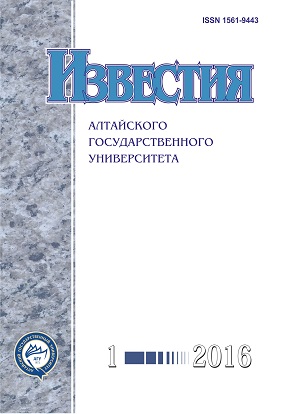A Virtual Instrument for Spectral Entropy Estimation of Heart Rate
Abstract
In this paper, a LabView-based virtual instrument for quantitative estimation of heart rate entropy is proposed. Quantitative estimation is obtained from spectral entropy of ordered time range intervals between RR-intervals. Spectral entropy is defined as a modified Shannon information entropy with power spectral density as a probability density function. The choice of power spectral density allows to overcome the task of interval width selection for probability density. We demonstrate block diagrams of the virtual instrument for estimation of spectral entropy of intervalograms and clinical trial results. Experiments proved that patients with normal sinus rhythm have spectral entropy Нср = 2.8 while patients with supraventricular arrhythmia have spectral entropy Нср = 3.1. Statistical significance of spectral entropy differences is obtained in accordance with t-Student criteria. Correlation analysis of ellipse area of scattergrams and spectral entropy of RR-intervalograms demonstrates that spectral entropy is not related to traditionally used ellipse area of scattergrams and, thus, can be utilized as an independent parameter in a heart rate evaluation process.
DOI 10.14258/izvasu(2016)1-07
Downloads
Metrics
References
Shen M.J., Zipes D.P. Role of the autonomic nervous system in modulating cardiac arrhythmias//Circulation Research. From Krannert Institute of Cardiology, Department of Medicine, Indiana University School of Medicine, Indianapolis, IN. -2014. -Vol. 114 (6).
Marek M. Heart rate variability. Standards of measurement, physiological interpretation, and clinical use//European Heart Journal. American Heart Association Inc.; European Society of Cardiology. U.K. -1996. -Vol. 17.
Da Silva V.P., de Oliveira N.A., Silveira H., Mello R.G., Deslandes A.C. Heart rate variability indexes as a marker of chronic adaptation in athletes: a systematic review//Annals of Noninvasive Electrocardiology: the Official Journal of the International Society for Holter and Noninvasive Electrocardiology. Rio de Janeiro, Brazil. -2015. -Vol. 20 (2).
Koenig J., Jarczok M.N., Wasner M., Hillecke T.K., Thayer J.F. Heart rate variability and swimming//Sports Medicine. Auckland, (N.Z.). -2014. -Vol. 44 (10).
Brateanu A. Heart rate variability after myocardial infarction: what we know and what we still need to find out//Current Medical Research and Opinion. Cleveland Clinic Foundation, Cleveland, OH, USA. -2015. -Vol. 31 (10).
Jergensen R.M., Abildstram S.Z., Levitan J., Kobo R. Heart Rate Variability Density Analysis and Prediction of Long-Term Mortality after Acute Myocardial Infarction//Annals of Noninvasive Electrocardiology: the Official Journal of the International Society for Holter and Noninvasive Electrocardiology, Denmark. -2015. -Vol. 20.
Li X., Yu S., Chen H., Lu C., Zhang K., Li F. Cardiovascular autonomic function analysis using approximate entropy from 24-h heart rate variability and its frequency components in patients with type 2 diabetes//Journal of Diabetes Investigation. China. -2015. -Vol. 6 (2).
Doret M., Spilka J., Chudacek V., Gonsalves P., Abry P Fractal Analysis and Hurst Parameter for Intrapartum Fetal Heart Rate Variability Analysis: A Versatile Alternative to Frequency Bands and LF/HF Ratio//PloS ONE. Department of Obstetrics and Gynaecology. Bron, France. -2015. -Vol. 10 (8). e0136661 DOI: 10.1371/journal.pone.0136661
Yeh H.M., Chang Y.C., Lin C., Yeh C.H., Lee C.N. A new method to derive fetal heart rate from maternal abdominal electrocardiogram: monitoring fetal heart rate during cesarean section//PloS ONE. Department of Anesthesiology, National Taiwan University Hospital, Taipei, Taiwan. -2015. -Vol. 10 (2). e0117509 DOI: 10.1371/journal.pone.0117509
Brandle J., Preissl H., Draganova R., Ortiz E. Heart rate variability parameters and fetal movement complement fetal behavioral states detection via magnetography to monitor neurovegetative development//Frontiers in Human Neuroscience. University of Tuebingen Tuebingen, Germany. -2015. -Vol. 9.
Sammito S., Bockelmann I. Analysis of heart rate variability. Mathematical description and practical application//Herz. Bereich Arbeitsmedizin der Medizinischen Fakultat, Otto-von-Guericke-Universitat Magdeburg, Leipziger. -2015. -Vol. 40 (1).
Gao J., Hu J., Liu F., Cao Y. Multiscale entropy analysis of biological signals: a fundamental bi-scaling law//Frontiers in Computational Neuroscience. Guangxi University Nanning, China. -2015.
Akiyama T., Miyazaki T., Ito H., Nogami H. Comparable accuracy of micro-electromechanical blood flowmetry-based analysis vs. electrocardiography-based analysis in evaluating heart rate variability//Circulation Journal: Official Journal of the Japanese Circulation Society. -2015. -Vol. 79 (4).
Jeyhani V., Mahdiani S., Peltokangas M. Comparison of HRV parameters derived from photoplethysmography and electrocardiography signals//Conference Proceedings: Annual International Conference of the IEEE Engineering in Medicine and Biology Society. IEEE Engineering in Medicine and Biology Society. -2015.
Баевский РМ., Иванов Г.Г., Чирейкин Л.В. и др. Анализ вариабельности сердечного ритма при использовании различных электрокардиографических систем (методические рекомендации)//Вестник аритмологии. -2001. -№ 24.
Аль-Хулейди Н.А., Исаков РВ., Сушкова Л.Т. Распознавание аритмий с помощью искусственных нейронных сетей//Биомедицинская радиоэлектроника. -2012. -№ 6.
Немирко А.П., Манило Л.А., Калиниченко А.Н. Интеллектуальный анализ биомедицинских сигналов//Биотехносфера. -2012. -№ 2.
Останин С.А., Шайдук А.М. Количественная оценка сложности контура медицинских изображений//Журнал радиоэлектроники. -2013. -№ 2 . -URL: http://jre.cplire.ru/jre/feb13/9/text.html
Общий ресурс сайта Physionet . -URL: http://www.physionet.org/physiobank/data-base/#ecg
Izvestiya of Altai State University is a golden publisher, as we allow self-archiving, but most importantly we are fully transparent about your rights.
Authors may present and discuss their findings ahead of publication: at biological or scientific conferences, on preprint servers, in public databases, and in blogs, wikis, tweets, and other informal communication channels.
Izvestiya of Altai State University allows authors to deposit manuscripts (currently under review or those for intended submission to Izvestiya of Altai State University) in non-commercial, pre-print servers such as ArXiv.
Authors who publish with this journal agree to the following terms:
- Authors retain copyright and grant the journal right of first publication with the work simultaneously licensed under a Creative Commons Attribution License (CC BY 4.0) that allows others to share the work with an acknowledgement of the work's authorship and initial publication in this journal.
- Authors are able to enter into separate, additional contractual arrangements for the non-exclusive distribution of the journal's published version of the work (e.g., post it to an institutional repository or publish it in a book), with an acknowledgement of its initial publication in this journal.
- Authors are permitted and encouraged to post their work online (e.g., in institutional repositories or on their website) prior to and during the submission process, as it can lead to productive exchanges, as well as earlier and greater citation of published work (See The Effect of Open Access).








